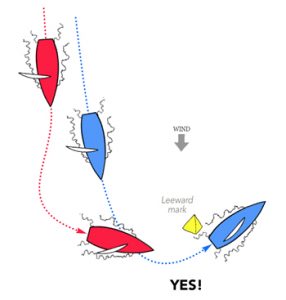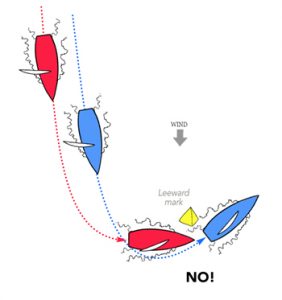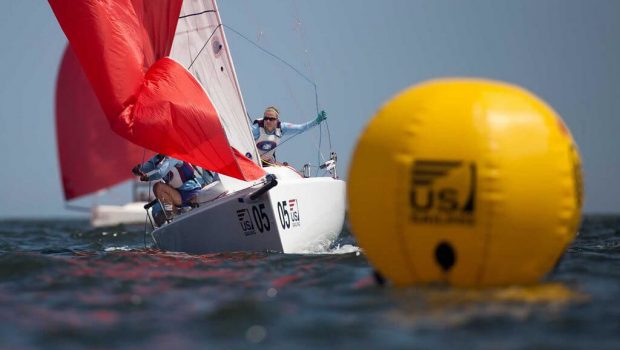When Slower is Faster
Published on June 6th, 2017
shares in the US Sailing blog how slowing down can put you ahead in a race.
The goal of a sailboat race is to beat your competitors to the finish line, so going full speed ahead is usually the best strategy. However, there are a few places on the race course where sailing slower may actually be faster. The leeward mark is one of them.
 At most leeward marks you end up rounding right behind another boat. This competitor and her wind shadow present a critical challenge. If you make too wide a rounding, for example, you’ll end up in her bad air, which is definitely slow.
At most leeward marks you end up rounding right behind another boat. This competitor and her wind shadow present a critical challenge. If you make too wide a rounding, for example, you’ll end up in her bad air, which is definitely slow.
When you exit from the leeward mark, you want to be at least slightly to windward of the centerline of the boat ahead so you have the option to keep sailing straight ahead in relatively clear air. In order to do this you must:
• Be 100% ready to race upwind before your bow gets to the leeward mark;
• Swing wide before the mark so you can pass very close to it (you should be able to reach out and touch it);
• Be going fast (faster than your close-hauled speed) when you get to the mark so you can use this speed to pinch up slightly above the boat ahead.
The best tactic to accomplish all this may be to slow down before the mark. If you keep going fast, you’ll end up right on the transom of the boat ahead. This may seem like a good rounding, but it has two problems:
1) If you misjudge your speed or if the other boat slows unexpectedly, you could hit them in the transom. Often the only way to avoid fouling is to bear off below them (which puts you right in their bad air).
2) The closer you are to the boat ahead, the more likely you are to be in (or fall into) their wind shadow.
 One good way to avoid both problems is to round the mark with a bigger gap between you and the boat ahead. I recommend at least half a boat length from your bow to the other boat’s transom. In certain boats and conditions, it may be smart to leave a full boat length between you and the boat ahead.
One good way to avoid both problems is to round the mark with a bigger gap between you and the boat ahead. I recommend at least half a boat length from your bow to the other boat’s transom. In certain boats and conditions, it may be smart to leave a full boat length between you and the boat ahead.
There are several advantages to creating this gap.
First, it reduces the risk of catching up to the boat ahead, which means you won’t have to avoid them by bearing off into their bad air. Second, it allows you to accelerate as you approach the mark (rather than slow down which is often the case when you’re afraid of catching up to the other boat). And third, the gap helps you avoid the wind shadow of the boat ahead. There is almost always clearer air a boat length behind a boat than right on her transom.
In most cases faster is better, but don’t be afraid to slow down when this tactic gives you more options and better control of your situation.
Learn more tips on how to improve your racing performance from Dave Dellenbaugh’s Speed & Smarts.
Source: US Sailing









 We’ll keep your information safe.
We’ll keep your information safe.